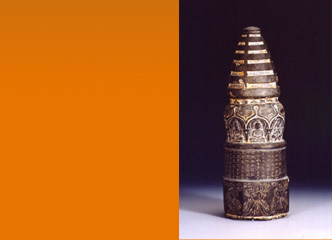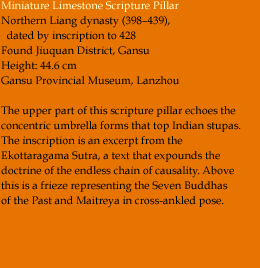 |
|
 |

"As rain pours through poorly thatched roofs, so does desire overwhelm the undeveloped mind." — Words of the Buddha from the Dhammapada According to tradition, the historical Buddha was born around 563 B.C.E. into an eminent family of the Sakya clan located among the foothills of the Himalayas between present-day Nepal and India. His personal name was Siddhartha, but he later became known as Sakyamuni (Sage of the Sakyas). At the age of twenty-nine he rejected the life of luxury in which he had been raised, leaving his home and family to seek understanding of the suffering and mortality inherent in all life. After years of searching, at the age of thirty-five, he found spiritual enlightenment during a night of meditation. Thereafter, he devoted the rest of his life to teaching the insights he had attained. The essence of the Buddha's teachings is embodied in "The Four Noble Truths": First, all life is suffering, second, suffering stems from desire, third, suffering can only end with the elimination of desire, fourth, this is achieved by following the Eightfold Path, focused on meditation, moral training, and discipline. Only by following these teachings can the individual reach enlightenment, or salvation, and, after death, the transcendent state known as nirvana. During the centuries following Sakyamuni's death, Buddhism evolved into an institutional religion. Monastic orders were formed and worship of the relics of the Buddha, and indeed the Buddha himself, became popular. Originally, the Buddha was represented only by the lotus or the stupa, but by the first century B.C.E. images of the Buddha began to appear. Although Buddhism was known in China during the Han dynasty, it was only after fall of the Han that it began to gain widespread popularity. A continuous stream of Buddhist missionaries from India and Central Asia found eager converts at every level of society and powerful patrons among the new nomad rulers of North China. The practice of Buddhism proved a potent stimulant to trade, with a growing demand for precious objects from afar, including incense from Central Asia, jewels and precious metals, coral, pearls, and lapis lazuli, all destined to adorn Buddhist temples, images, and reliquaries. The form of Buddhism that became dominant in China was Mahayana ("The Greater Vehicle"). Mahayana Buddhism emphasized the potential salvation of all living beings and the concept of compassion. The embodiment of this ideal of universal compassion was the bodhisattva, beings who have attained enlightenment but who defer their entry into nirvana to aid others. A popular Mahayana scripture, the Lotus Sutra, taught that making holy images was an act of the highest merit on the road to enlightenment. Mahayana converts became China's greatest art patrons, supporting the building of cave temples and pagodas, the carving of statues and stelae (stone tablets), and the translation and copying of Buddhist sutras. |
||||